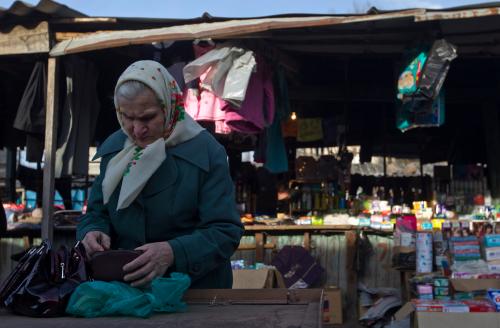Georgia recently commemorated a quarter century of independence. And there were good reasons to celebrate given what progress those 25 years brought. But for the country to reach high-middle income, it will need to build upon earlier successes while thinking about new paths for sustained economic growth.
Those of us who were adults in the mid-1990s probably remember Georgia as an extremely poor, post-Soviet, quasi-failed state, only gaining publicity during crisis. Today, Georgia conjures radically different associations: good food and wine, pristine landscapes, and a vibrant democratic trajectory that put the country on a fast-track path of reform.
These contrasting narratives can also be seen in economic data, as well as in the global indicators that rank how countries reform and improve their institutions and governance. In the aftermath of the collapse of the Soviet Union, already poor Georgia experienced an unprecedented economic contraction, even by regional standards. Corruption and dysfunctional governance were rife. Several years later, and especially after the Rose Revolution, the country has sustained high rates of growth—in the absence of a natural resources base. Its international ranking on leading indicators, such as Doing Business or Transparency Corruption Perception index, has also surged from the bottom to the top.
This incredible success story begs the questions: What does Georgia need to do to continue its growth trajectory? And does Georgia really need a new development model?
The forthcoming Georgia Systematic Country Diagnostics of the World Bank Group, titled “From Reformer to Performer,” argues that Georgia doesn’t need a new model as much as a new strategy to operationalize it.
In the new bestselling book, ”What Got You Here Won’t Get You There,” management guru Marshall Goldsmith argues that certain individual characteristics, such as focus, hard work, and drive allow employees to quickly move up the career ladder. However, he also stresses that reaching the next level requires adjustment and refinement to these core skills and competencies: Increasingly, action needs to be balanced with reflection, and taking initiative with stepping back.
This theory of performance thresholds and qualitative breaks is also useful in thinking about development pathways, specifically the challenge that has been dubbed the middle-income trap. The concept applies to those economies that grew steadily from low- to middle-income, only to hit a plateau.
To get “from here to there” in their development journey, countries like Georgia that have successfully climbed the first steps of the ladder need to continue building on their core competencies and areas of excellence, but also recalibrate their models.
What have we found in Georgia?
There is no need to fundamentally rethink its development model because Georgia has already built a foundation to succeed in the future. To firmly become a higher-middle income economy and expand the reach of the middle class to most of the population by doubling income per capita by 2030, Georgia needs to continue to grow at the average rate of the past decade, around 5 percent per capita. This will require building on earlier successes, such as expanding improvements to governance to local levels and across institutions. At the sector level, this would entail building on the Georgia brand for tourism, agriculture products, and design.
But a recalibration will also be required in the following ways:
- Rekindling productivity growth will be key. After reaping initial productivity gains when the economy was liberalized and restructured, growth has been driven mostly by capital accumulation with modest contributions from productivity growth. Increasing productivity at the individual and firm level will be necessary for Georgia to sustain its growth trajectory.
- Export orientation needs a boost. One of the strongest drivers of productivity growth is the integration of firms into global value chains, through attracting efficiency seeking foreign direct investment and opening up to internal and external competition.
- Greater connectivity is critical. Georgia can benefit from Asia’s re-emergence and China’s investments into a new silk road, officially known as the Belt and Road Initiative. Currently, Georgia’s connectivity—both transport and digital—remains moderate and would need substantial upgrading to benefit from global value chains.
To enter a new prosperity cycle, Georgia’s efforts must boost the productivity of workers and firms (see figure). This will require greater integration into the world economy, as well as a fuller and better deployment of the country’s human and natural assets. Georgia has already taken steps in this direction and is more integrated into the world economy than a decade ago (for example, in tourism). For the next decade, Georgia needs to build upon these gains to usher in new prosperity in which the interaction between firms and workers will be crucial. Better trade integration and logistics will help attract foreign investment and integrate Georgian firms and products into global value chains, increasing productivity and further raising Georgia’s competitiveness.
Figure 1: A prosperity cycle for Georgia
Source: Georgia Systematic Country Diagnostics, World Bank, forthcoming
This will also demand better skilled and mobile workers, an issue we will discuss in a subsequent blog post. Human development in Georgia is both critical for competitiveness and social inclusion, especially in light of the country’s demographic decline. For now, let us contribute to the 25th Anniversary celebrations and wish Georgia the bright future it deserves.









Commentary
From reformer to performer: How Georgia can build upon its economic success
March 1, 2018